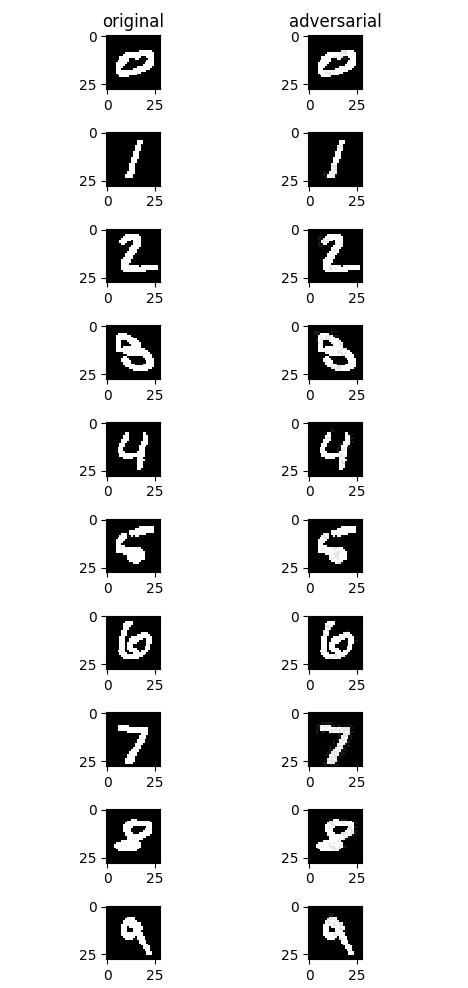使用NAD算法提升模型安全性
Linux Ascend GPU CPU 模型训练 模型调优 企业 高级
概述
本教程介绍MindArmour提供的模型安全防护手段,引导您快速使用MindArmour,为您的AI模型提供一定的安全防护能力。
AI算法设计之初普遍未考虑相关的安全威胁,使得AI算法的判断结果容易被恶意攻击者影响,导致AI系统判断失准。攻击者在原始样本处加入人类不易察觉的微小扰动,导致深度学习模型误判,称为对抗样本攻击。MindArmour模型安全提供对抗样本生成、对抗样本检测、模型防御、攻防效果评估等功能,为AI模型安全研究和AI应用安全提供重要支撑。
对抗样本生成模块支持安全工程师快速高效地生成对抗样本,用于攻击AI模型。
对抗样本检测、防御模块支持用户检测过滤对抗样本、增强AI模型对于对抗样本的鲁棒性。
评估模块提供多种指标全面评估对抗样本攻防性能。
这里通过图像分类任务上的对抗性攻防,以攻击算法FGSM和防御算法NAD为例,介绍MindArmour在对抗攻防上的使用方法。
本例面向CPU、GPU、Ascend 910 AI处理器,你可以在这里下载完整的样例代码: https://gitee.com/mindspore/mindarmour/blob/r1.2/examples/model_security/model_defenses/mnist_defense_nad.py
建立被攻击模型
以MNIST为示范数据集,自定义的简单模型作为被攻击模型。
引入相关包
import os
import numpy as np
from scipy.special import softmax
from mindspore import dataset as ds
from mindspore import dtype as mstype
import mindspore.dataset.vision.c_transforms as CV
import mindspore.dataset.transforms.c_transforms as C
from mindspore.dataset.vision import Inter
import mindspore.nn as nn
from mindspore.nn import SoftmaxCrossEntropyWithLogits
from mindspore.common.initializer import TruncatedNormal
from mindspore import Model, Tensor, context
from mindspore.train.callback import LossMonitor
from mindarmour.adv_robustness.attacks import FastGradientSignMethod
from mindarmour.utils.logger import LogUtil
from mindarmour.adv_robustness.evaluations import AttackEvaluate
context.set_context(mode=context.GRAPH_MODE, device_target="Ascend")
LOGGER = LogUtil.get_instance()
LOGGER.set_level("INFO")
TAG = 'demo'
加载数据集
利用MindSpore的dataset提供的MnistDataset接口加载MNIST数据集。
# generate dataset for train of test
def generate_mnist_dataset(data_path, batch_size=32, repeat_size=1,
num_parallel_workers=1, sparse=True):
"""
create dataset for training or testing
"""
# define dataset
ds1 = ds.MnistDataset(data_path)
# define operation parameters
resize_height, resize_width = 32, 32
rescale = 1.0 / 255.0
shift = 0.0
# define map operations
resize_op = CV.Resize((resize_height, resize_width),
interpolation=Inter.LINEAR)
rescale_op = CV.Rescale(rescale, shift)
hwc2chw_op = CV.HWC2CHW()
type_cast_op = C.TypeCast(mstype.int32)
# apply map operations on images
if not sparse:
one_hot_enco = C.OneHot(10)
ds1 = ds1.map(operations=one_hot_enco, input_columns="label",
num_parallel_workers=num_parallel_workers)
type_cast_op = C.TypeCast(mstype.float32)
ds1 = ds1.map(operations=type_cast_op, input_columns="label",
num_parallel_workers=num_parallel_workers)
ds1 = ds1.map(operations=resize_op, input_columns="image",
num_parallel_workers=num_parallel_workers)
ds1 = ds1.map(operations=rescale_op, input_columns="image",
num_parallel_workers=num_parallel_workers)
ds1 = ds1.map(operations=hwc2chw_op, input_columns="image",
num_parallel_workers=num_parallel_workers)
# apply DatasetOps
buffer_size = 10000
ds1 = ds1.shuffle(buffer_size=buffer_size)
ds1 = ds1.batch(batch_size, drop_remainder=True)
ds1 = ds1.repeat(repeat_size)
return ds1
建立模型
这里以LeNet模型为例,您也可以建立训练自己的模型。
定义LeNet模型网络。
def conv(in_channels, out_channels, kernel_size, stride=1, padding=0): weight = weight_variable() return nn.Conv2d(in_channels, out_channels, kernel_size=kernel_size, stride=stride, padding=padding, weight_init=weight, has_bias=False, pad_mode="valid") def fc_with_initialize(input_channels, out_channels): weight = weight_variable() bias = weight_variable() return nn.Dense(input_channels, out_channels, weight, bias) def weight_variable(): return TruncatedNormal(0.02) class LeNet5(nn.Cell): """ Lenet network """ def __init__(self): super(LeNet5, self).__init__() self.conv1 = conv(1, 6, 5) self.conv2 = conv(6, 16, 5) self.fc1 = fc_with_initialize(16*5*5, 120) self.fc2 = fc_with_initialize(120, 84) self.fc3 = fc_with_initialize(84, 10) self.relu = nn.ReLU() self.max_pool2d = nn.MaxPool2d(kernel_size=2, stride=2) self.flatten = nn.Flatten() def construct(self, x): x = self.conv1(x) x = self.relu(x) x = self.max_pool2d(x) x = self.conv2(x) x = self.relu(x) x = self.max_pool2d(x) x = self.flatten(x) x = self.fc1(x) x = self.relu(x) x = self.fc2(x) x = self.relu(x) x = self.fc3(x) return x
训练LeNet模型。利用上面定义的数据加载函数
generate_mnist_dataset载入数据。mnist_path = "../common/dataset/MNIST/" batch_size = 32 # train original model ds_train = generate_mnist_dataset(os.path.join(mnist_path, "train"), batch_size=batch_size, repeat_size=1, sparse=False) net = LeNet5() loss = SoftmaxCrossEntropyWithLogits(sparse=False) opt = nn.Momentum(net.trainable_params(), 0.01, 0.09) model = Model(net, loss, opt, metrics=None) model.train(10, ds_train, callbacks=[LossMonitor()], dataset_sink_mode=False) # 2. get test data ds_test = generate_mnist_dataset(os.path.join(mnist_path, "test"), batch_size=batch_size, repeat_size=1, sparse=False) inputs = [] labels = [] for data in ds_test.create_tuple_iterator(): inputs.append(data[0].asnumpy().astype(np.float32)) labels.append(data[1].asnumpy()) test_inputs = np.concatenate(inputs) test_labels = np.concatenate(labels)
测试模型。
# prediction accuracy before attack net.set_train(False) test_logits = net(Tensor(test_inputs)).asnumpy() tmp = np.argmax(test_logits, axis=1) == np.argmax(test_labels, axis=1) accuracy = np.mean(tmp) LOGGER.info(TAG, 'prediction accuracy before attacking is : %s', accuracy)
测试结果中分类精度达到了98%。
prediction accuracy before attacking is : 0.9895833333333334
对抗性攻击
调用MindArmour提供的FGSM接口(FastGradientSignMethod)。
# attacking
# get adv data
attack = FastGradientSignMethod(net, eps=0.3, loss_fn=loss)
adv_data = attack.batch_generate(test_inputs, test_labels)
# get accuracy of adv data on original model
adv_logits = net(Tensor(adv_data)).asnumpy()
adv_proba = softmax(adv_logits, axis=1)
tmp = np.argmax(adv_proba, axis=1) == np.argmax(test_labels, axis=1)
accuracy_adv = np.mean(tmp)
LOGGER.info(TAG, 'prediction accuracy after attacking is : %s', accuracy_adv)
attack_evaluate = AttackEvaluate(test_inputs.transpose(0, 2, 3, 1),
test_labels,
adv_data.transpose(0, 2, 3, 1),
adv_proba)
LOGGER.info(TAG, 'mis-classification rate of adversaries is : %s',
attack_evaluate.mis_classification_rate())
LOGGER.info(TAG, 'The average confidence of adversarial class is : %s',
attack_evaluate.avg_conf_adv_class())
LOGGER.info(TAG, 'The average confidence of true class is : %s',
attack_evaluate.avg_conf_true_class())
LOGGER.info(TAG, 'The average distance (l0, l2, linf) between original '
'samples and adversarial samples are: %s',
attack_evaluate.avg_lp_distance())
LOGGER.info(TAG, 'The average structural similarity between original '
'samples and adversarial samples are: %s',
attack_evaluate.avg_ssim())
攻击结果如下:
prediction accuracy after attacking is : 0.052083
mis-classification rate of adversaries is : 0.947917
The average confidence of adversarial class is : 0.803375
The average confidence of true class is : 0.042139
The average distance (l0, l2, linf) between original samples and adversarial samples are: (1.698870, 0.465888, 0.300000)
The average structural similarity between original samples and adversarial samples are: 0.332538
对模型进行FGSM无目标攻击后,模型精度由98.9%降到5.2%,误分类率高达95%,成功攻击的对抗样本的预测类别的平均置信度(ACAC)为 0.803375,成功攻击的对抗样本的真实类别的平均置信度(ACTC)为 0.042139,同时给出了生成的对抗样本与原始样本的零范数距离、二范数距离和无穷范数距离,平均每个对抗样本与原始样本间的结构相似性为0.332538,平均每生成一张对抗样本所需时间为0.003125s。
攻击前后效果如下图,左侧为原始样本,右侧为FGSM无目标攻击后生成的对抗样本。从视觉角度而言,右侧图片与左侧图片几乎没有明显变化,但是均成功误导了模型,使模型将其误分类为其他非正确类别。

对抗性防御
NaturalAdversarialDefense(NAD)是一种简单有效的对抗样本防御方法,使用对抗训练的方式,在模型训练的过程中构建对抗样本,并将对抗样本与原始样本混合,一起训练模型。随着训练次数的增加,模型在训练的过程中提升对于对抗样本的鲁棒性。NAD算法使用FGSM作为攻击算法,构建对抗样本。
防御实现
调用MindArmour提供的NAD防御接口(NaturalAdversarialDefense)。
from mindarmour.adv_robustness.defenses import NaturalAdversarialDefense
# defense
net.set_train()
nad = NaturalAdversarialDefense(net, loss_fn=loss, optimizer=opt,
bounds=(0.0, 1.0), eps=0.3)
nad.batch_defense(test_inputs, test_labels, batch_size=32, epochs=10)
# get accuracy of test data on defensed model
net.set_train(False)
test_logits = net(Tensor(test_inputs)).asnumpy()
tmp = np.argmax(test_logits, axis=1) == np.argmax(test_labels, axis=1)
accuracy = np.mean(tmp)
LOGGER.info(TAG, 'accuracy of TEST data on defensed model is : %s', accuracy)
# get accuracy of adv data on defensed model
adv_logits = net(Tensor(adv_data)).asnumpy()
adv_proba = softmax(adv_logits, axis=1)
tmp = np.argmax(adv_proba, axis=1) == np.argmax(test_labels, axis=1)
accuracy_adv = np.mean(tmp)
attack_evaluate = AttackEvaluate(test_inputs.transpose(0, 2, 3, 1),
test_labels,
adv_data.transpose(0, 2, 3, 1),
adv_proba)
LOGGER.info(TAG, 'accuracy of adv data on defensed model is : %s',
np.mean(accuracy_adv))
LOGGER.info(TAG, 'defense mis-classification rate of adversaries is : %s',
attack_evaluate.mis_classification_rate())
LOGGER.info(TAG, 'The average confidence of adversarial class is : %s',
attack_evaluate.avg_conf_adv_class())
LOGGER.info(TAG, 'The average confidence of true class is : %s',
attack_evaluate.avg_conf_true_class())
防御效果
accuracy of TEST data on defensed model is : 0.974259
accuracy of adv data on defensed model is : 0.856370
defense mis-classification rate of adversaries is : 0.143629
The average confidence of adversarial class is : 0.616670
The average confidence of true class is : 0.177374
使用NAD进行对抗样本防御后,模型对于对抗样本的误分类率从95%降至14%,模型有效地防御了对抗样本。同时,模型对于原来测试数据集的分类精度达97%。


